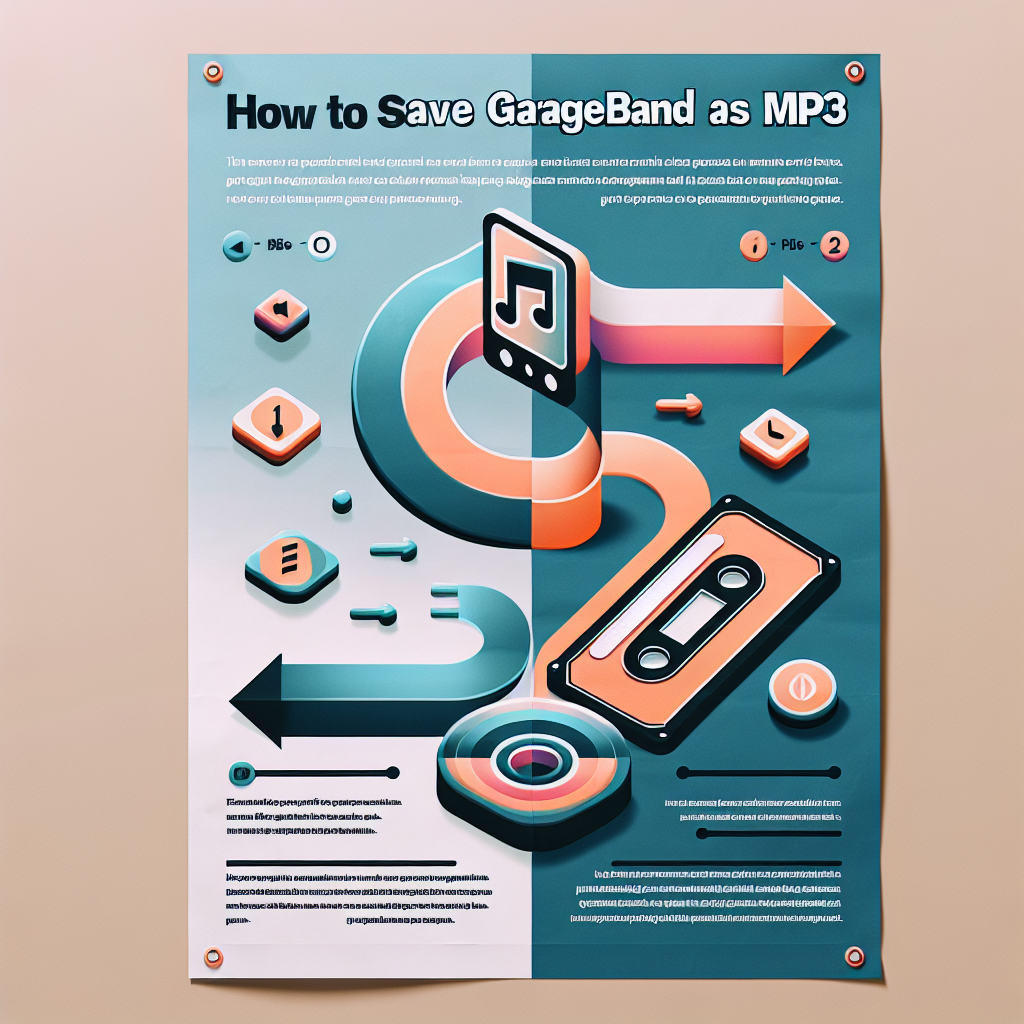
GarageBand has revolutionized the way we create music, making it accessible for everyone from beginners to professional musicians. Its intuitive interface, coupled with a vast library of instruments and sound effects, allows users to craft their unique music projects with ease. But when it comes to sharing your creations with the world, knowing how to save GarageBand as MP3 can be crucial. This audio format is universally compatible, ensuring your music files can be played on any device, maintaining the sound quality your work deserves.
Why Convert GarageBand File to MP3?
The need to convert GarageBand file to MP3 stems from the desire to make music sharing simpler and more efficient. Whether you’re looking to share your latest track on social media, with friends, or professional platforms, converting your GarageBand project to an audio file in MP3 format ensures compatibility and ease of access. Moreover, MP3 files are known for their balance between sound quality and file size, making them ideal for online sharing without compromising the integrity of your audio exporting.
The Process of GarageBand Export to MP3
Exporting audio from GarageBand might seem daunting at first, but the process is straightforward. Here’s how to save GarageBand as MP3, ensuring your music file is ready for the world:
- GarageBand Settings: Navigate to your GarageBand project and dive into the audio settings. Here, you’ll find options tailored for audio conversion.
- Audio Exporting: Look for the GarageBand export or share option within the menu. Selecting this will prompt you to choose the desired audio format.
- GarageBand to MP3: Among the list of formats, select MP3. You may also adjust the sound quality settings to suit your needs, balancing file size and fidelity.
Benefits of MP3 Format for GarageBand Sharing
Choosing MP3 as your audio format for GarageBand sharing comes with several advantages. Firstly, the ubiquity of MP3 ensures that your audio file can be played back on virtually any device, from smartphones to home entertainment systems. Additionally, MP3 files are smaller in size compared to other formats, facilitating quicker uploads and downloads, a boon for both creators and listeners. Lastly, despite the compression, MP3 files can still retain excellent sound quality, making it a preferred choice for audio exporting.
For those looking to expand their musical horizons with GarageBand on Windows, a safe and verified version is available for download at sound effects. This version of GarageBand for Windows operates without the need for emulators, offering a straightforward, click-and-play experience. It’s a hassle-free way to dive into the world of music production, ensuring that users can focus on their creativity without technical barriers.
Navigating the Download and Installation of GarageBand for Windows
Embarking on the journey to download and install GarageBand for Windows can be an exciting venture for any music enthusiast. This section will guide you through the necessary steps, ensuring a smooth setup so you can start creating music in no time.
Step 1: Downloading GarageBand for Windows
Begin by searching for a reputable source for GarageBand for Windows. Ensure the website is known for its credibility and safety to avoid any potential harm to your computer. Once located, click on the download link for GarageBand. The download process will start, and you might need to specify a folder to save the installer file.
Step 2: Running the Installer
After the download is complete, navigate to the downloaded installer file. Double-click on it to initiate the installation process. You might see a prompt asking for permission to allow the app to make changes to your device. Click ‘Yes’ to proceed.
Step 3: Following Installation Instructions
The installer will guide you through the necessary steps. This typically involves agreeing to the terms and conditions, choosing an installation location, and selecting any additional components you might want to install. It’s generally recommended to stick with the default settings unless you have specific preferences.
Step 4: Completing the Installation
Once you’ve followed all the prompts, the installation will begin. This process might take a few minutes, depending on your system’s performance. Upon completion, you’ll often see a final screen indicating that GarageBand has been successfully installed on your Windows device. You might be prompted to restart your computer to finalize the setup.
Step 5: Launching GarageBand
After your computer has restarted, you can launch GarageBand by clicking on its icon, either on your desktop or from the start menu. Upon the first launch, you might need to configure some initial settings, such as audio input and output devices. This setup is crucial for ensuring the best possible audio quality for your projects.
Tips for a Smooth GarageBand Experience on Windows
- Update Your Audio Drivers: Ensure your audio drivers are up to date to prevent any compatibility issues.
- Allocate Sufficient Storage: High-quality audio files can be large, so make sure you have enough storage space available.
- Familiarize Yourself with the Interface: Spend some time exploring GarageBand’s features and settings. The more comfortable you are with the interface, the more efficiently you can create music.
As you embark on your musical journey with GarageBand for Windows, remember that creativity knows no bounds. This powerful tool opens up a world of possibilities, allowing you to experiment with different sounds and styles. Whether you’re crafting your next hit song, composing a soundtrack, or simply exploring the realms of music production, GarageBand serves as a versatile companion.
Let the rhythm of inspiration guide you as you navigate through the myriad of features and tools at your disposal. With each note, you’re not just making music; you’re telling a story. And in this digital age, where stories can transcend borders and touch hearts globally, your creations have the potential to resonate with listeners far and wide. So, let the symphony of your imagination play on, for in the world of music, every note counts, and every melody tells a tale.
Embarking on the journey of music creation with GarageBand not only opens up a world of possibilities but also introduces a canvas for endless creativity. Whether you’re a budding musician or an experienced producer, the transition from GarageBand projects to universally compatible MP3 files is a pivotal step in sharing your artistry with the world. Here are additional tips and tricks to enhance your GarageBand experience and ensure your music reaches its highest potential.
Enhance Your GarageBand Projects
- Utilize Keyboard Shortcuts: Mastering keyboard shortcuts can significantly speed up your workflow. Familiarize yourself with shortcuts for common actions like splitting tracks, duplicating sections, or adding new tracks to make your music production process more efficient.
- Experiment with Loops and Instruments: GarageBand offers a vast library of loops and virtual instruments. Don’t hesitate to experiment with these resources. Mixing different genres and sounds can lead to unique musical compositions.
- Optimize Track Layers: Be mindful of the number of tracks and effects you use. More layers can enrich the sound but also make the mix muddy. Use EQ settings and panning to give each instrument its space in the mix.
Sharing Your Music
Once your GarageBand project is polished and ready, converting it to an MP3 file is just the beginning of its journey. Here’s how to ensure your music stands out:
- Metadata Matters: When exporting your project, don’t overlook the importance of metadata. Adding details like the track name, artist, and genre can make your music files more professional and easier to discover.
- Quality vs. File Size: While MP3 is a compressed format, choosing a higher bitrate can significantly improve sound quality. A bitrate of 256 kbps strikes a good balance between quality and file size for most projects.
- Feedback and Improvement: Share your creations with a trusted circle of friends or fellow musicians for constructive feedback. Use this input to refine your skills and your tracks.
Beyond the Basics
- Collaborate Online: GarageBand allows for easy collaboration. Share your project files with friends or bandmates to work on songs together, even if you’re miles apart.
- Continuous Learning: The landscape of music production is ever-evolving. Stay curious and continue learning new techniques, tools, and trends in the industry.
As the final note of your latest GarageBand creation fades out, and you prepare to share your musical journey with the world, remember that every artist was once a beginner. The path from initial chords to finalized MP3s is paved with both challenges and triumphs. Yet, it’s the passion for music and the joy of creation that makes this journey worthwhile.
Let each project be a stepping stone towards mastering the art of music production. With GarageBand, your computer becomes a gateway to expressing your musical vision, and converting your projects to MP3 ensures your melodies can resonate far and wide.
As you continue to explore, create, and share, let the rhythm of your creativity be the guide. The world is eager to hear your story, one note at a time. So, let the music play on, for in the grand symphony of life, your compositions add a unique and unforgettable melody.
Navigating the Symphony of Sound: A Deep Dive into GarageBand’s Audio Export Capabilities
GarageBand, Apple’s flagship digital audio workstation, is not just a tool; it’s a canvas for musicians, podcasters, and creators of all stripes. Its intuitive design and comprehensive features allow users to craft intricate music projects with ease. However, the true magic begins when it’s time to share these creations with the world. Understanding the nuances of exporting audio, converting a GarageBand file to an MP3 format, and ensuring the sound quality remains pristine is crucial. Let’s explore the detailed process and some frequently asked questions that might arise during your musical journey.
The Art of Audio Exporting from GarageBand
Exporting audio from GarageBand involves a few critical steps that ensure your music file is ready for any platform. First, navigate to your GarageBand settings and delve into the audio settings. This is where your journey of audio conversion begins. Select the GarageBand export or share option, and choose MP3 as your audio format. Here, you have the liberty to adjust the sound quality settings, finding the perfect balance between file size and audio fidelity.
The Symphony of Formats: Why MP3?
The choice of MP3 for your GarageBand project is no coincidence. This audio format is celebrated for its universal compatibility, ensuring your music files can be played across a myriad of devices without a hitch. Moreover, the MP3 format is known for its efficient balance between sound quality and file size, making it the ideal choice for GarageBand sharing.
FAQs on GarageBand Audio Exporting
Q: How do I ensure the best sound quality when exporting my GarageBand project?
A: To ensure the best sound quality, select a higher bitrate during the audio exporting process. A bitrate of 256 kbps or higher is recommended for a good balance between quality and file size.
Q: Can I convert my GarageBand file to formats other than MP3?
A: Yes, GarageBand supports various audio formats for export. While MP3 is popular for its compatibility, you can also choose AAC, AIFF, or WAV depending on your needs.
Q: How do I adjust the audio settings before exporting my project?
A: Navigate to the GarageBand settings and select the audio settings option. Here, you can adjust the output quality, including bitrate and sample rate, to tailor the final audio file to your preferences.
Q: Is there a difference in the export process for different versions of GarageBand?
A: While the core steps remain consistent, newer versions of GarageBand might offer additional features or streamlined options for audio exporting. Always check the latest user guide or help section for version-specific instructions.
Q: Can I share my GarageBand project directly to social media platforms?
A: Yes, GarageBand offers sharing options that allow you to directly upload your music file to various social media platforms. However, converting to MP3 ensures broader compatibility across all platforms.
Crafting Your Musical Legacy with GarageBand
As you embark on this journey of audio conversion and sharing, remember that each GarageBand project is a reflection of your creativity and passion. The process of transforming your compositions into universally playable MP3 files is not just about technical steps; it’s about ensuring your music reaches and resonates with listeners everywhere.
Whether you’re a budding musician laying down your first track or a seasoned producer refining your latest masterpiece, the power of GarageBand coupled with the versatility of MP3 format opens up endless possibilities. From the intricate layers of your music project to the final audio file ready for the world, every step is a note in the grand symphony of your musical journey.
As you continue to explore, create, and share, let the rhythm of your creativity guide you. And remember, for a safe and seamless experience, ensure you’re downloading GarageBand from a reputable source. For those looking to dive into the world of music production on Windows, a safe download awaits by clicking the download button below. Your next masterpiece is just a project away, and the world is eager to hear the music you have to offer.




